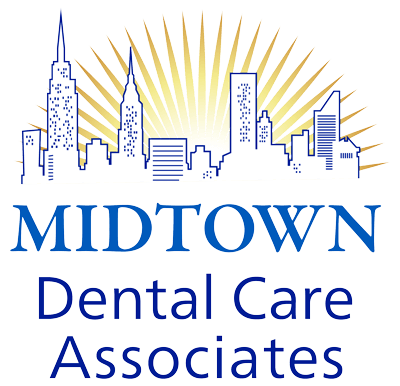Gum Grafting in Midtown NYC
If gum recession is present and tooth roots are exposed, a gum graft may be recommended. This procedure is used to control and prevent further gum recession and subsequent damage to the surrounding teeth and bone structure. Often, a soft tissue graft also improves the appearance of a patient’s smile and sensitivity to heat and cold.
During a soft tissue graft, tissue is surgically placed to cover as much of the exposed root area as possible. Often, a tissue flap is created to allow the added tissue to be joined to the existing gums to facilitate tissue growth and healing. This procedure may be used to treat one or several adjacent teeth at the time of the surgery.
The tissue used for the graft may be taken from the roof of the patient’s mouth or from a tissue bank. If taken from the roof of the patient’s mouth, the procedure may involve cutting a flap in order to use tissue beneath the outer layer and then stitching the flap back in place. This is known as a connective tissue graft and is the most common procedure used for gum grafting. There are times when the soft tissue of the patient does not allow for this and a free gingival graft is recommended in order to use the stronger tissue taken directly from the palate. A third technique, known as a pedicle graft, is sometimes possible in patients who have more gum tissue near the exposed area. For this procedure, gum tissue surrounding the exposed area is loosened and repositioned in order to cover the exposed root and encourage tissue growth and healing.
For any of these procedures, the gum graft will be stitched into place and healing will begin immediately following surgery. In order to facilitate healing, our office will sometimes choose to use Platelet Rich Growth Factors (PRGF) or Platelet Rich Fibrin (PRF). These new techniques are applied to the surgical site(s) in the form of a gel and can assist with tissue regeneration by using the patient’s own tissues and centrifugation to minimize healing time and maximize healing potential following procedures.
Why it may be recommended…
There are several reasons a gum grafting procedure may be recommended for a patient.
Cosmetic
There are times when there are cosmetic reasons to perform a gum graft. In these cases, a soft tissue graft can improve the appearance of a smile even if the patient does not have a medical reason to perform the procedure. If gum tissue is uneven or not providing sufficient coverage of the tooth root, a patient may elect to have a gum graft to improve the appearance of their smile and make the teeth appear more proportionate or even.
Comfort
The most common reason to perform a gum grafting procedure is to correct the effects of gum recession. Gum recession can be mild and is often a natural part of aging, but the receding gums can expose part of the tooth root and cause sensitivity to heat and cold. Patients may choose to have a gum graft to reduce the sensitivity they are experiencing as a result of gum recession.
Health
More often, however, gum recession is the result of periodontal disease and there are important oral health and medical reasons to perform a gum grafting procedure in Midtown. The recession not only affects the aesthetics of the smile and tooth sensitivity, but overall oral health and wellness. Receding gums leave tooth roots exposed and vulnerable to decay, instability and tooth loss, which can then lead to loss of the bone structure supporting the teeth. Gum grafts are an effective way to cover and protect tooth roots, helping extend the health of the tooth and supporting bone structures.

